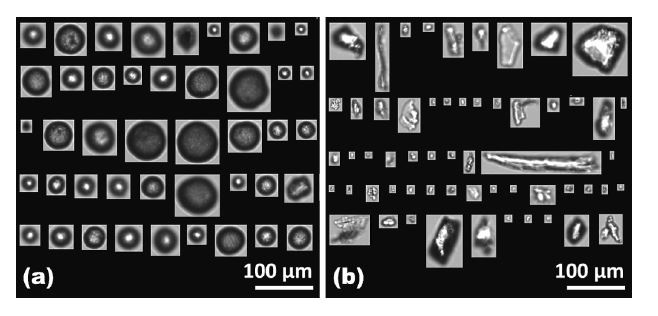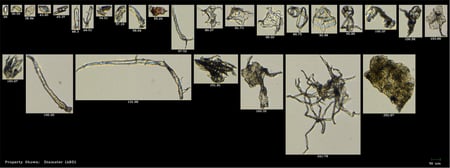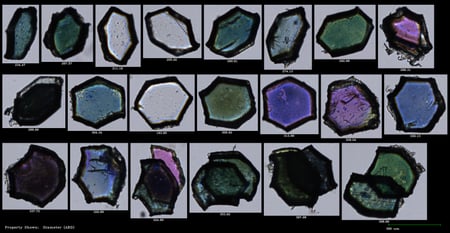Two recently published research studies from Ewha Womans University in Seoul, Korea, hold significance due to their exploration of FlowCam's capabilities in analyzing polyethylene (PE) and polyamide (PA) microplastics. Wastewater Treatment Plants (WWTPs) play a crucial role in managing microplastic pollution, yet current methods exhibit limitations in efficiency. This leads to the discharge of microplastics into the ocean and results in ongoing significant pollutants in our oceans. These studies address the urgent need for rapid and accurate measurement techniques in the context of microplastic characterization.
Pictured above are representative FlowCam images of reference microplastics for a) PE and b) PA microplastics in the single samples.
Membrane-based treatment methods utilizing size exclusion present a viable option for treating wastewater containing microplastics (and other contaminants). The challenge at hand involves accurately identifying and characterizing microplastics, especially in mixed samples containing both PE and PA microplastics. Traditional size measurements are inadequate, and there is a need to explore confidence intervals for constructing libraries that can precisely identify target materials in diverse samples.
FlowCam Solution
FlowCam, an innovative microscopy technique, has been employed to collect multiple measurements related to the properties of PE and PA microplastics. Custom image libraries were constructed for each microplastic type, and automated classification was implemented using FlowCam's VisualSpreadsheet software. This approach provides a streamlined and efficient method for capturing and sorting particle images.
FlowCam emerges as a robust solution to the challenge, revolutionizing the process of capturing, cropping, and sorting particle images. Its automated high-resolution digital imaging capability allows for real-time quantification and extraction of relevant parameters, making it a valuable tool in microbiology and microplastic characterization.
In this study, the authors find that FlowCam offers a non-destructive approach to microplastic characterization, eliminating the need for chemical degradation in sample preparation. This uniqueness ensures the preservation of microplastic materials, offering a distinct advantage over traditional methods.
New in this Research
These studies introduce geometric and morphological parameters to enhance the accuracy and comprehensiveness of microplastic observations. Utilizing custom libraries based on complex measurement outputs from FlowCam represents a new and promising technology for rapid and straightforward analysis of target microplastics within mixed samples.
The study evaluates confidence intervals' impact on microplastic properties and investigates their removal mechanisms, transport behavior, and transformation in wastewater through membrane filtration. The authors compare how the geometry and morphology of PE and PA microplastics affect retention mechanisms and membrane fouling in filtration systems.
Conclusion
These findings demonstrate the significant role of microplastic geometry and morphology in retention mechanisms and membrane fouling. The authors highlight the potential of FlowCam for microplastic identification and quantification in wastewater while providing a valuable basis for the characterization of microplastic transformations within membrane filtration systems.
The unique capabilities of FlowCam, coupled with its non-destructive approach and automated imaging, position it as a valuable tool for future advancements in microplastic characterization and environmental science.
Interested in learning more about using FlowCam for microplastics research?
Download our new application note
Read the full papers:











